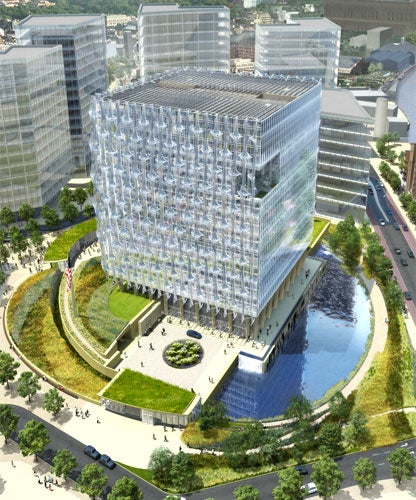For its new English home, America builds a castle

With its moat, car bomb-proof stand-off zone and clear view of any approaching terrorists, it could be 21st-century version of a castle.
Despite features designed to convey international confidence and architectural brio, the winning design for the new £275m US embassy in London, announced yesterday, epitomises the post-9/11 bunker-mentality that has swept through embassy design since the Twin Towers fell.
It was a David and Goliath moment when KieranTimberlake's design was chosen by the architectural competition jury – who included Richard Rogers. KieranTimberlake is widely admired for the firm's meticulously designed campus buildings in America, but is hardly perceived as internationally "hot" compared to the behemoths it was competing against: Richard Meier, Morphosis, and PEI Cobb Freed and Partners, whose principals have all won architecture's Oscar, the Pritzker prize.
But security is a great leveller. Just like the architectural deities they were up against, Stephen Kieran and James Timberlake were forced to design an embassy that would be hard to damage or approach at anything quicker than a cautious, Pooterish amble. British architects weren't allowed to compete in the design competition for the new embassy because of security worries. The Foreign and Commonwealth Office, on the other hand, has been happy to let American architects design some of our new embassies, presumably because the FCO trusts them as part of the "special relationship".
It's hard to be subtle about 21st-century anti-terrorist measures: embassies are, increasingly, built away from dense urban areas, on flat ground with clear fields of vision. The dominant feature of the embassy, which is relocating from Mayfair to the south bank of the Thames in Battersea, is the 30m wide stand-off zone around the building, complete with moat – albeit visually softened by surrounding gardens with changing levels. In essence, the stand-off makes it impossible for the building to be rammed at speed by a truck filled with explosives.
The US Department of State said the building would "contribute significantly to the urban fabric of the historic city of London through the demonstration of exceptional American architecture, technology and sustainability". It will be carbon-neutral; it will have biomass boilers; it will have crystal-like ethylene-tetrafluoroethylene scrims – don't ask! – on its façades; it will have art-walls and internal gardens.
There's more: "It will speak to the time-honoured relationship between the US and the UK and will reflect the values of the American people." A fine sentiment, but rather undermined by the moat that will repel all unwelcome comers to the embassy's Nine Elms site on the south bank of the Thames in Battersea.
Is KieranTimberlake's design great architecture? Not on the evidence of the visuals, although in technical and operational terms it will probably be outstanding. It certainly wasn't the most intriguing design of the four on the final shortlist. Richard Meier's scheme had a great deal more distinction in terms of its coolly abstract form. And the offering from PEI Cobb Freed and Partners promised beautifully refined façades. These two schemes had a gravitas that KieranTimberlake's seems to lack.
Of the losers, Mr Meier will be the least disturbed. "I would rather," he has said, "build a project in the US than anywhere else in the world. America is the place where freedom, productivity, experimentation and innovation meet." One so hopes these things will catch on here soon.
Join our commenting forum
Join thought-provoking conversations, follow other Independent readers and see their replies
Comments